This document provides an overview of NumPy arrays in 3 paragraphs. It begins by introducing NumPy as the core library for scientific computing in Python that consists of multidimensional array objects. The second paragraph describes one-dimensional and two-dimensional NumPy arrays, how to create them using functions like array(), and basic operations like slicing and joining arrays. The third paragraph covers various arithmetic operations that can be performed on one-dimensional and two-dimensional arrays like addition, subtraction, multiplication, and division.
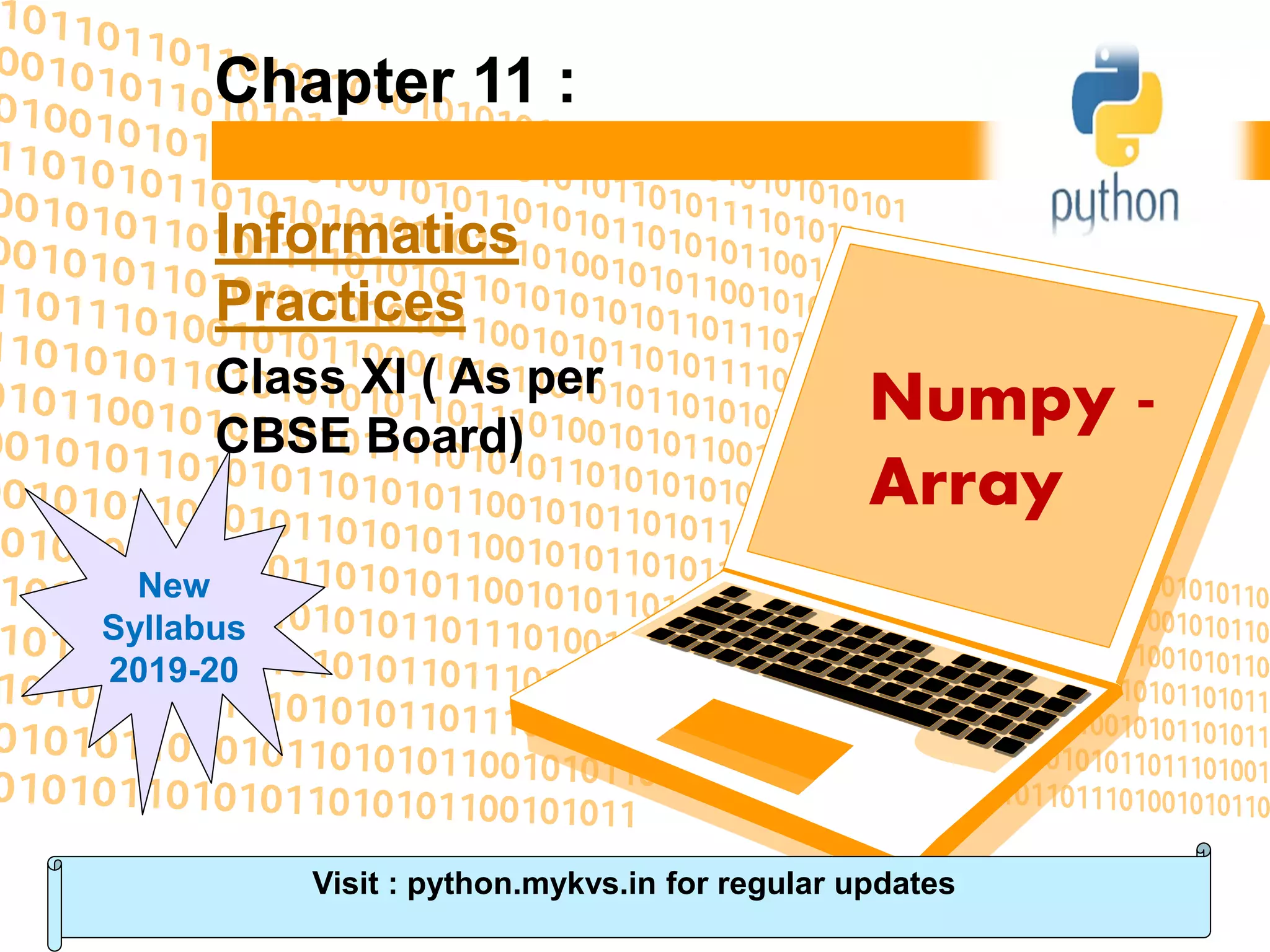
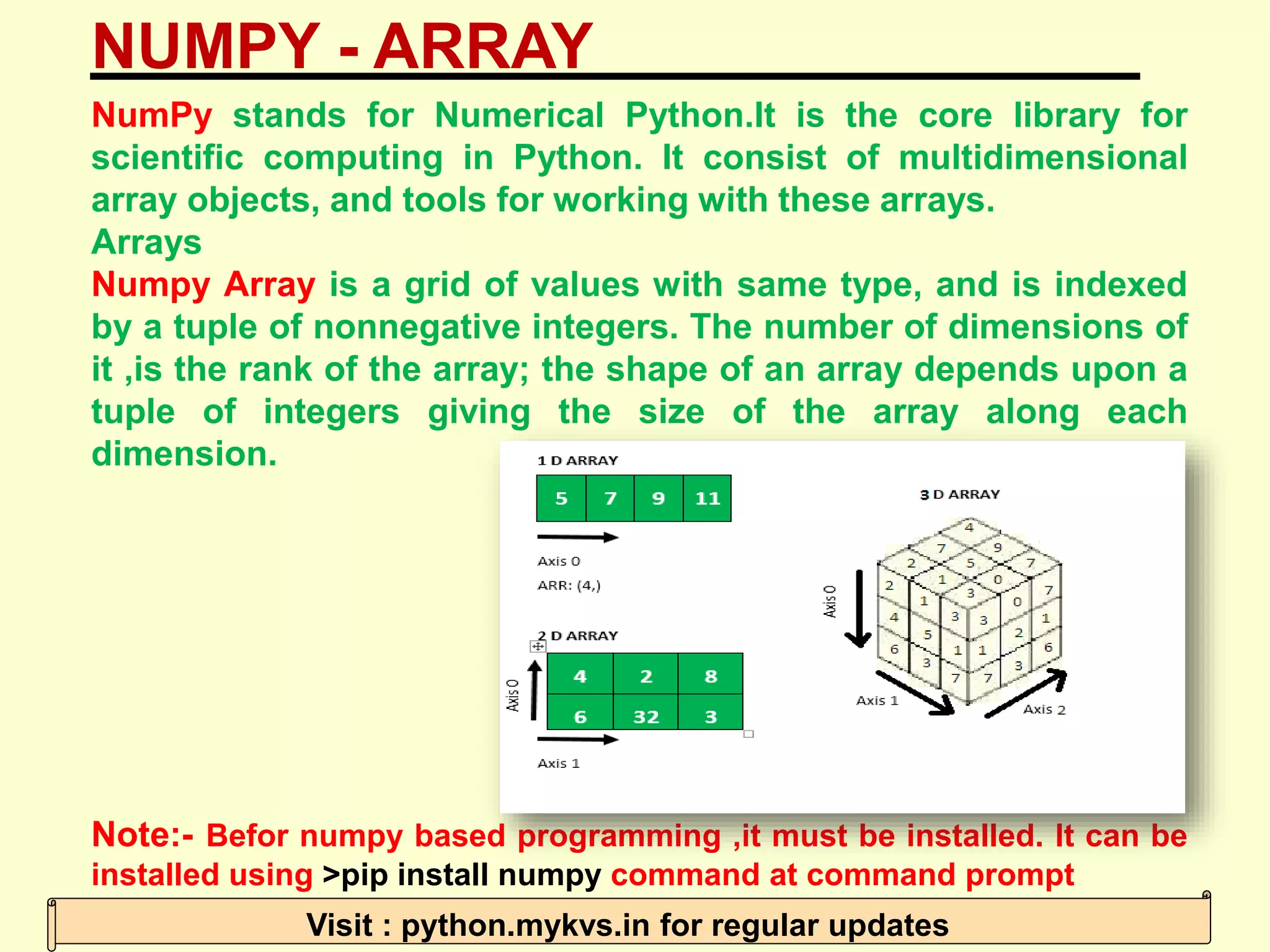
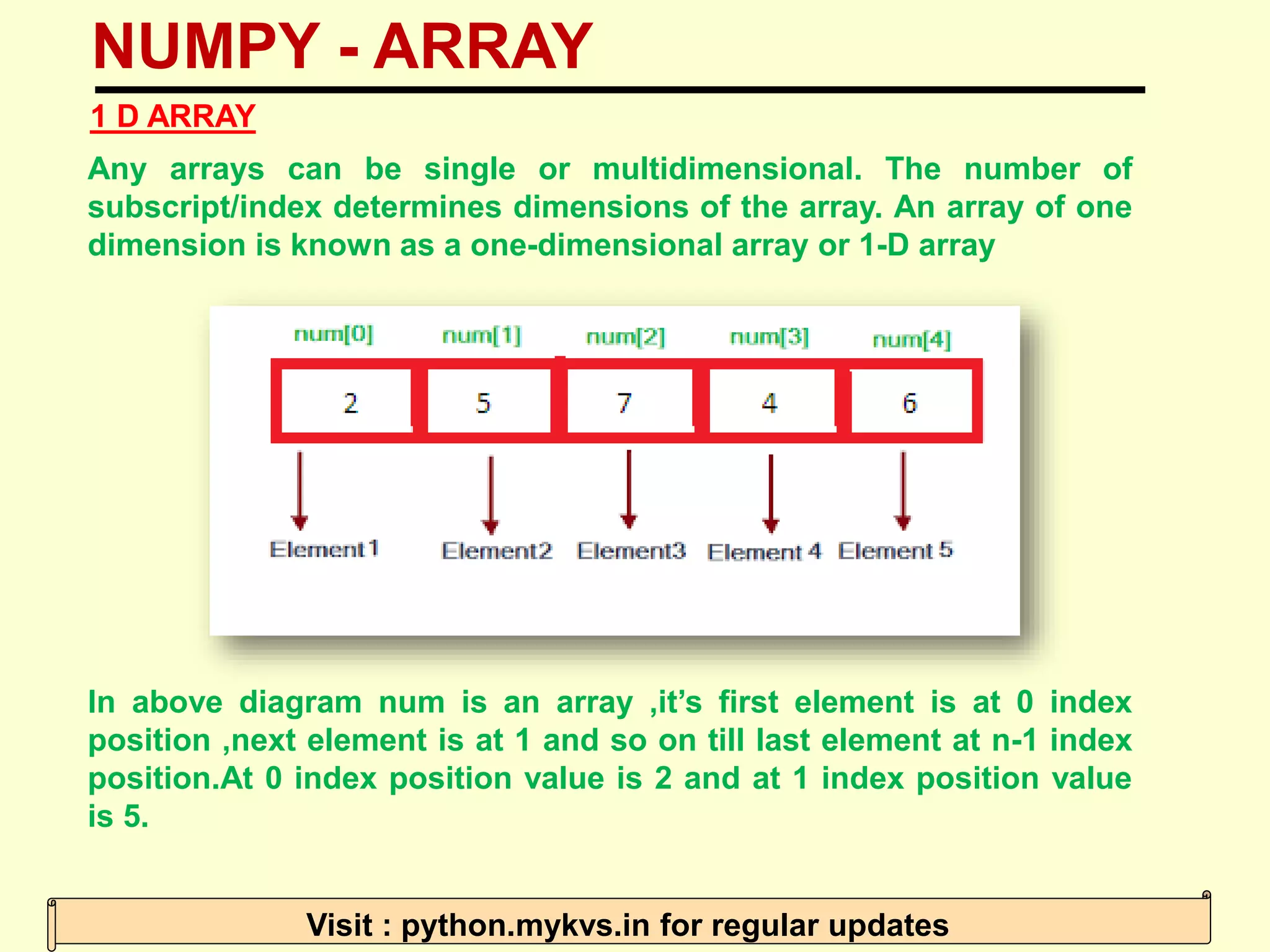
![NUMPY - ARRAY Visit : python.mykvs.in for regular updates 1 D ARRAY Creation of 1D array One dimension array can be created using array method with list object with one dimensional elements. e.g.program import numpy as np a = np.array([500, 200, 300]) # Create a 1D Array print(type(a)) # Prints "<class 'numpy.ndarray'>" print(a.shape) # Prints "(3,)" means dimension of array print(a[0], a[1], a[2]) # Prints "500 200 300" a[0] = 150 # Change an element of the array print(a)](https://image.slidesharecdn.com/numpy-array-230223085459-aecf1dce/75/Numpy-Array-pdf-4-2048.jpg)
![NUMPY - ARRAY Visit : python.mykvs.in for regular updates 1 D ARRAY Creation of 1D array Using functions import numpy as np p = np.empty(5) # Create an array of 5 elements with random values print(p) a1 = np.zeros(5) # Create an array of all zeros float values print(a1) # Prints "[0. 0. 0. 0. 0.]" a2 = np.zeros(5, dtype = np.int) # Create an array of all zeros int values print(a2) # Prints "[0. 0. 0. 0. 0.]" b = np.ones(5) # Create an array of all ones print(b) # Prints "[1. 1. 1. 1. 1.]" c = np.full(5, 7) # Create a constant array print(c) # Prints "[7 7 7 7 7]" e = np.random.random(5) # Create an array filled with random values print(e)](https://image.slidesharecdn.com/numpy-array-230223085459-aecf1dce/75/Numpy-Array-pdf-5-2048.jpg)
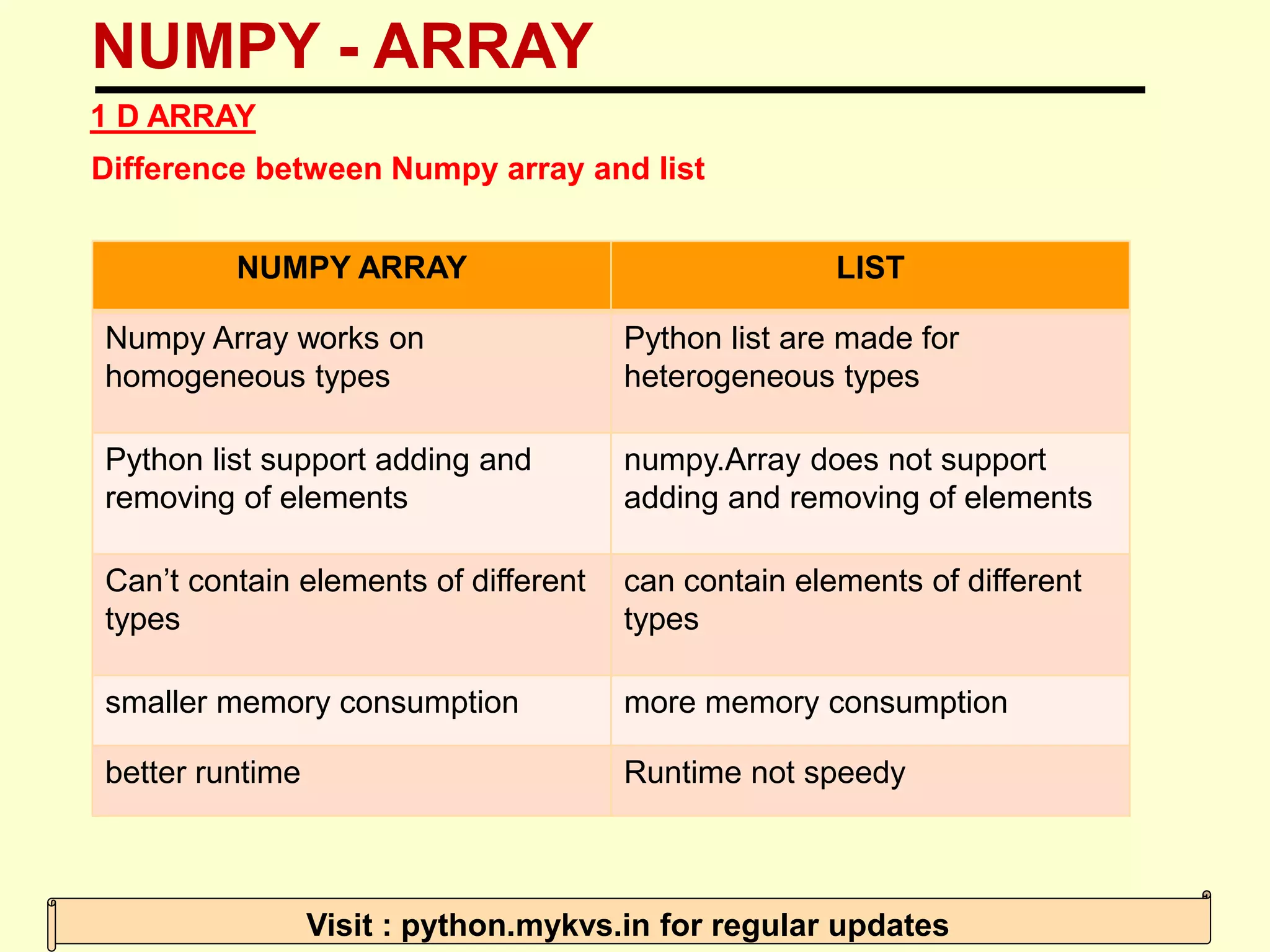
![NUMPY - ARRAY Visit : python.mykvs.in for regular updates 1 D ARRAY Create 1D from string import numpy as np data =np.fromstring('1 2', dtype=int, sep=' ') print(data) Note:- in fromstring dtype and sep argument can be changed. Create 1D from buffer numpy array from range numpy.arange(start, stop, step, dtype) #program 1 import numpy as np x = np.arange(5) #for float value specify dtype = float as argument print(x) #print [0 1 2 3 4] #program 2 import numpy as np x = np.arange(10,20,2) print (x) #print [10 12 14 16 18]](https://image.slidesharecdn.com/numpy-array-230223085459-aecf1dce/75/Numpy-Array-pdf-7-2048.jpg)
![NUMPY - ARRAY Visit : python.mykvs.in for regular updates 1 D ARRAY Create 1D from array Copy function is used to create the copy of the existing array. e.g.program import numpy as np x = np.array([1, 2, 3]) y = x z = np.copy(x) x[0] = 10 print(x) print(y) print(z) Note that, when we modify x, y changes, but not z:](https://image.slidesharecdn.com/numpy-array-230223085459-aecf1dce/75/Numpy-Array-pdf-8-2048.jpg)
![NUMPY - ARRAY Visit : python.mykvs.in for regular updates 1 D ARRAY SLICES Slicing of numpy array elements is just similar to slicing of list elements. e.g.program import numpy as np data = np.array([5,2,7,3,9]) print (data[:]) #print [5 2 7 3 9] print(data[1:3]) #print [2 7] print(data[:2]) #print [5 2] print(data[-2:]) #print [3 9]](https://image.slidesharecdn.com/numpy-array-230223085459-aecf1dce/75/Numpy-Array-pdf-9-2048.jpg)
![NUMPY - ARRAY Visit : python.mykvs.in for regular updates 1 D ARRAY JOINING Joining of two or more one dimensional array is possible with the help of concatenate() function of numpy object. e.g.program import numpy as np a = np.array([1, 2, 3]) b = np.array([5, 6]) c=np.concatenate([a,b,a]) print(c) #print [1 2 3 5 6 1 2 3]](https://image.slidesharecdn.com/numpy-array-230223085459-aecf1dce/75/Numpy-Array-pdf-10-2048.jpg)
![NUMPY - ARRAY Visit : python.mykvs.in for regular updates Print all subsets of a 1D Array If A {1, 3, 5}, then all the possible/proper subsets of A are { }, {1}, {3}, {5}, {1, 3}, {3, 5} e.g.program import pandas as pd import numpy as np def sub_lists(list1): # store all the sublists sublist = [[]] # first loop for i in range(len(list1) + 1): # second loop for j in range(i + 1, len(list1) + 1): # slice the subarray sub = list1[i:j] sublist.append(sub) return sublist x = np.array([1, 2, 3,4]) # driver code print(sub_lists(x)) OUTPUT [[], array([1]), array([1, 2]), array([1, 2, 3]), array([1, 2, 3, 4]), array([2]), array([2, 3]), array([2, 3, 4]), array([3]), array([3, 4]), array([4])]](https://image.slidesharecdn.com/numpy-array-230223085459-aecf1dce/75/Numpy-Array-pdf-11-2048.jpg)
![NUMPY - ARRAY Visit : python.mykvs.in for regular updates Basic arithmetic operation on 1D Array e.g.program import numpy as np x = np.array([1, 2, 3,4]) y = np.array([1, 2, 3,4]) z=x+y print(z) #print [2 4 6 8] z=x-y print(z) #print [0 0 0 0] z=x*y print(z) #print [ 1 4 9 16] z=x/y print(z) #print [1. 1. 1. 1.] z=x+1 print(z) #print [2 3 4 5] Aggregate operation on 1D Array e.g.program import numpy as np x = np.array([1, 2, 3,4]) print(x.sum()) #print 10 print(x.min()) #print 1 print(x.max()) #print 4 print(x.mean())#print 2.5 print(np.median(x))#print 2.5](https://image.slidesharecdn.com/numpy-array-230223085459-aecf1dce/75/Numpy-Array-pdf-12-2048.jpg)
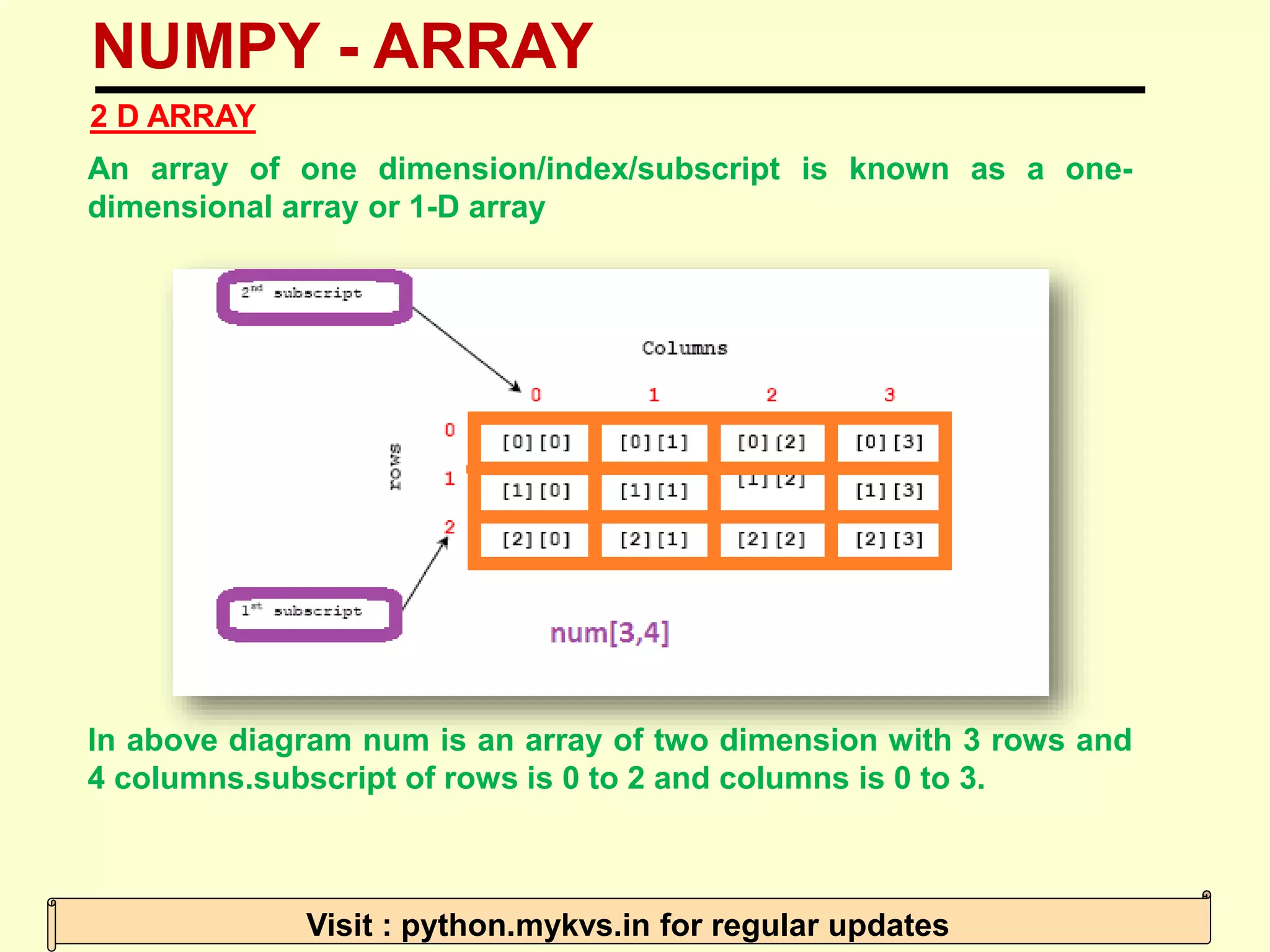
![NUMPY - ARRAY Visit : python.mykvs.in for regular updates 2 D ARRAY Creation of 2D array Two dimension array can be created using array method with list object with two dimensional elements. e.g.program import numpy as np a = np.array([[3, 2, 1],[1, 2, 3]]) # Create a 2D Array print(type(a)) # Prints "<class 'numpy.ndarray'>" print(a.shape) # Prints (2, 3) print(a[0][1]) # Prints 2 a[0][1] = 150 # Change an element of the array print(a) # prints [[ 3 150 1] [ 1 2 3]]](https://image.slidesharecdn.com/numpy-array-230223085459-aecf1dce/75/Numpy-Array-pdf-14-2048.jpg)
![NUMPY - ARRAY Visit : python.mykvs.in for regular updates 2 D ARRAY Creation of 2D array Using functions import numpy as np p = np.empty([2,2]) # Create an array of 4 elements with random values print(p) a1 = np.zeros([2,2]) # Create 2d array of all zeros float values print(a1) # Prints [[0. 0.][0. 0.]] a2 = np.zeros([2,2], dtype = np.int) # Create an array of all zeros int values print(a2) # Prints [[0 0] [0 0]] b = np.ones([2,2]) # Create an array of all ones print(b) # Prints [[1. 1.] [1. 1.]] c = np.full([2,2], 7) # Create a constant array print(c) # Prints [[7 7] [7 7]] e = np.random.random([2,2]) # Create 2d array filled with random values print(e)](https://image.slidesharecdn.com/numpy-array-230223085459-aecf1dce/75/Numpy-Array-pdf-15-2048.jpg)
![NUMPY - ARRAY Visit : python.mykvs.in for regular updates 2D ARRAY Creation of 2D array from 1D array We can create 2D array from 1d array using reshape() function. e.g. program import numpy as np A = np.array([1,2,3,4,5,6]) B = np.reshape(A, (2, 3)) print(B) OUTPUT [[1 2 3] [4 5 6]]](https://image.slidesharecdn.com/numpy-array-230223085459-aecf1dce/75/Numpy-Array-pdf-16-2048.jpg)
![NUMPY - ARRAY Visit : python.mykvs.in for regular updates 2 D ARRAY SLICES Slicing of numpy 2d array elements is just similar to slicing of list elements with 2 dimension. e.g.program import numpy as np A = np.array([[7, 5, 9, 4], [ 7, 6, 8, 8], [ 1, 6, 7, 7]]) print(A[:2, :3]) #print elements of 0,1 rows and 0,1,2 columns print(A[:3, ::2]) #print elements of 0,1,2 rows and alternate column position print(A[::-1, ::-1]) #print elements in reverse order print(A[:, 0]) #print all elements of 0 column print(A[0, :]) #print all elements of 0 rows print(A[0]) #print all elements of 0 row](https://image.slidesharecdn.com/numpy-array-230223085459-aecf1dce/75/Numpy-Array-pdf-17-2048.jpg)
![NUMPY - ARRAY Visit : python.mykvs.in for regular updates 2 D ARRAY JOINING e.g.program import numpy as np A = np.array([[7, 5], [1, 6]]) # concatenate along the first axis print(np.concatenate([A, A])) # concatenate along the second axis (zero-indexed) print(np.concatenate([A, A], axis=1)) x = np.array([1, 2]) # vertically stack the arrays print(np.vstack([x, A])) # horizontally stack the arrays y = np.array([[99], [99]]) print(np.hstack([A, y])) OUTPUT [[7 5] [1 6] [7 5] [1 6]] [[7 5 7 5] [1 6 1 6]] [[1 2] [7 5] [1 6]] [[ 7 5 99] [ 1 6 99]]](https://image.slidesharecdn.com/numpy-array-230223085459-aecf1dce/75/Numpy-Array-pdf-18-2048.jpg)
![NUMPY - ARRAY Visit : python.mykvs.in for regular updates 2 D ARRAY – ARITHMATIC OPERATION Arithmetic operation over 2d array is possible with add,substract,multiply,divide () functions. E.G.PROGRAM import numpy as np a = np.array([[7, 5, 9], [ 2, 6, 8]]) print(a) b = np.array([10,10,10]) c=np.add(a,b) # c=a+b, similar print(c) c=np.subtract(a,b) # c=a-b, similar print(c) c=np.multiply(a,b) # c=a*b, similar print(c) c=np.divide(a,b) # c=a/b, similar print(c) OUTPUT [[7 5 9] [2 6 8]] [[17 15 19] [12 16 18]] [[-3 -5 -1] [-8 -4 -2]] [[70 50 90] [20 60 80]] [[0.7 0.5 0.9] [0.2 0.6 0.8]] Note:- 1. if both 2d arrays are with same dimension[matrix form] then one to one arithmetic operation will be performed. 2. No of elements of a dimension must match otherwise error message thrown](https://image.slidesharecdn.com/numpy-array-230223085459-aecf1dce/75/Numpy-Array-pdf-19-2048.jpg)
![NUMPY - ARRAY Visit : python.mykvs.in for regular updates 2 D ARRAY – ARITHMATIC OPERATION Arithmetic operation over 2d array can be done with single value also. E.G.PROGRAM import numpy as np a = np.array([[7, 5, 9], [ 2, 6, 8]]) print(a) c=np.add(a,2) print(c) c=np.subtract(a,2) print(c) c=np.multiply(a,2) print(c) c=np.divide(a,2) print(c) OUTPUT [[7 5 9] [2 6 8]] [[ 9 7 11] [ 4 8 10]] [[5 3 7] [0 4 6]] [[14 10 18] [ 4 12 16]] [[3.5 2.5 4.5] [1. 3. 4. ]]](https://image.slidesharecdn.com/numpy-array-230223085459-aecf1dce/75/Numpy-Array-pdf-20-2048.jpg)
![NUMPY - ARRAY Visit : python.mykvs.in for regular updates 2 D ARRAY – Mathematical Functions Maths functions like power,abs,ceil,floor,around and trigonometric functions like sin,cos,tan,asin etc are supported by numpy E.G.PROGRAM import numpy as np a = np.array([[7.333, 5.223], [ 2.572, 6.119]]) print(np.power(a,2)) print(np.ceil(a)) print(np.floor(a)) print(np.around(a,1)) OUTPUT [[53.772889 27.279729] [ 6.615184 37.442161]] [[8. 6.] [3. 7.]] [[7. 5.] [2. 6.]] [[7.3 5.2] [2.6 6.1]]](https://image.slidesharecdn.com/numpy-array-230223085459-aecf1dce/75/Numpy-Array-pdf-21-2048.jpg)